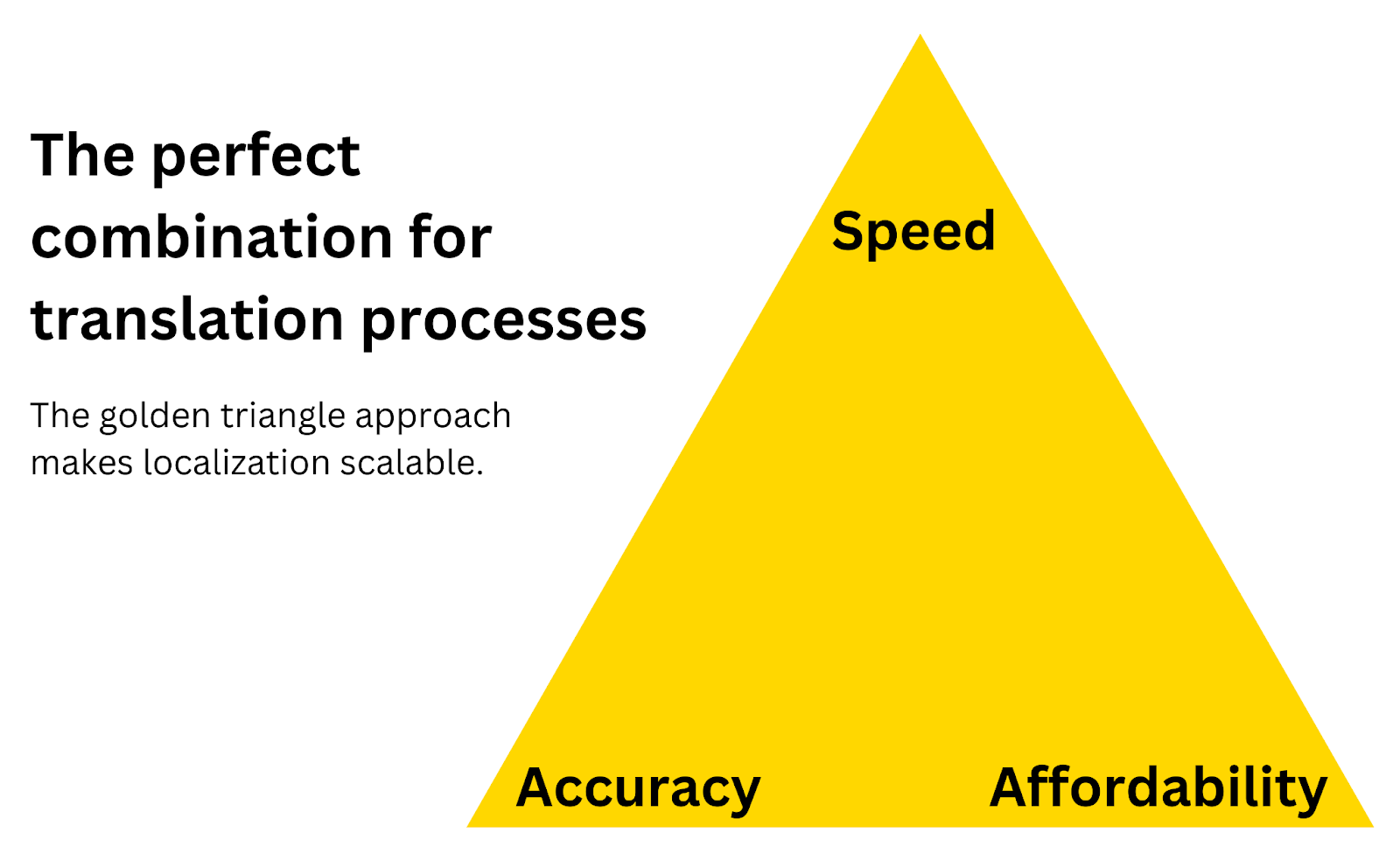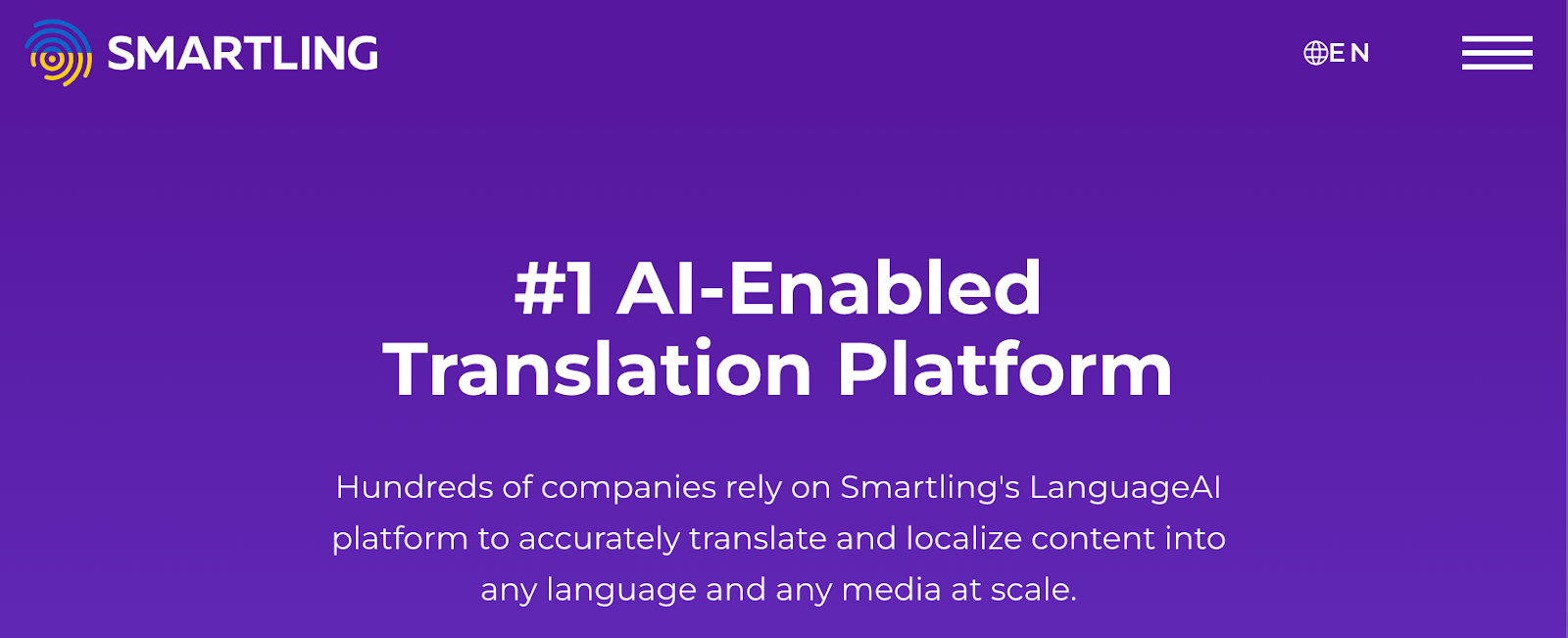Developing perfect localized translations has been a long and winding path. Purely human translations offered the attention and care that companies needed to localize content, but they always faced common human errors and lengthy, costly processes due to using traditional methods. These challenges also made local market expansion difficult to scale.
Then AI translators came along. They were quick, affordable, and efficient, but they lacked the human expertise to localize content and maintain brand standards. Additionally, different online AI translator engines offered varying strengths and weaknesses.
But today, businesses can overcome these challenges with the right solution thanks to innovation. Brands can fulfill translation needs for scalable localization using machine translation, AI-assisted human translators, and collaboration tools.
Teams can produce higher-quality translations at a fraction of the cost with a more efficient AI translator online process, which can translate content in seconds.
The golden triangle: speed, accuracy, and affordability
Brands no longer have to sacrifice high-quality translations for speed and affordability. Today's technology provides solutions for localization teams to expand into markets and reach multilingual audiences using practical online AI technology.
The golden triangle of the translation process emphasizes the three core pillars that teams need so they can produce successful translations at scale:  Leveraging innovative AI translation tools helps businesses scale localization with speed, accuracy, and affordability.
Leveraging innovative AI translation tools helps businesses scale localization with speed, accuracy, and affordability.
- Speed: Brands can now produce translations in large quantities by employing neural machine translation (NMT) technology to quickly translate billions of words.
- Accuracy: Linguistic assets like translation memory, glossaries, computer-assisted translation tools, and machine learning can help teams eliminate common human errors and produce on-brand translations in context.
- Affordability: With budget-friendly modern AI and translation software tools, brands can grow their translation strategy at a fraction of traditional costs and without thousands of hours of human labor. They can then use these tools to expand and manage translations in multiple new multilingual markets.
Before, these pillars were costly and difficult to execute with human translators alone. Additionally, pioneering AI translation tools offered fast and affordable translation but missed key localization needs like cultural nuances and brand preferences. Modern technology unites local expert human linguistics and AI translators to create fast, accurate, and affordable translated content.
How AI translators are changing the game
Now that the golden triangle is finally a reality, localization teams can scale their translation efforts so their content connects with multilingual audiences like a local business’s messaging would.
Online AI translators, or top SaaS translation platforms, can help teams translate at scale while maintaining quality and cost within a translation management system (TMS). This technology helps expert translators collaborate, develop a workflow, and verify translation quality after an AI performs the initial translation.
Since machine translation does most of the heavy lifting, local experts can shift their time and resources to complex and unique cases. They can also ensure that content meets quality standards and continue to develop your brand voice so machine learning models can improve.
The practical benefits of AI translators online
Innovative AI translator solutions open the doors to high-growth localization potential. Companies can benefit from these six perks of incorporating AI translation services into the translation process:
1. Translate bulk amounts of source text
Before AI, it seemed almost impossible to localize and translate content into a few new languages, let alone dozens of other languages and cultures. Now, companies can translate source language content in bulk. NMT technology makes bulk translations possible by using translation engines to produce accurate translated content. Not only can brands produce high-quality translations in seconds, but they can also shift their resources for new market expansion. Since translations have become far more feasible, companies can now reach more multilingual audiences.
2. Maintain a consistent brand voice
Speed and literal accuracy won't solve every translation need. When set with the wrong parameters, fast translations can cause even more damage, like a race car driver who turns the wheel just a bit too far and causes a major crash. That's why AI translation tools should maintain your core brand message. As a company, you want your brand voice to consistently communicate the same tone and message across all languages. That means a customer in the UK and a customer in China will read the same brand message despite speaking different languages. Think about how a public speaker conveys a message when using an interpreter. Everything the speaker says passes through someone else, so the meaning might be either on-point or altered. In the same way, brands should ensure that their process offers the same voice across all languages.
AI technologies and machine learning help you improve and solidify your brand voice across cultures. Companies can market their brands with an effective singular identity and perceived value.
3. Incorporate local human translation experts
Along with brand voice consistency, AI translation tools should offer the ability to integrate human expertise.
In one target language or culture, "affordable" might mean "cheap quality," while another may perceive it as "the best value for your dollar." That's why it's essential to incorporate human expert translators into your translation process.
These experts should be native speakers who are familiar with your brand voice and product or service. They also understand the culture you want to reach better than anyone else and know what nuances to expect within people groups, communities, age groups, traditions, languages, and other critical cultural groups.
The more effectively an online AI translator can manage and collaborate on localized translations, the more likely it is that you will produce a higher-quality output and connect with your target audience.
4. Save costs and expand into new markets
AI translators are affordable and scalable and save companies millions of dollars over the years. Since machine translators can produce translations in milliseconds, companies don't have to rely on slow, expensive human processes to get most of the job done.
Since companies can produce faster translations, they can use their saved time and costs to expand into more markets. Human experts can then improve AI translation output and verify that translations meet localization standards.
5. Improve your current multilingual market translations
It's exciting to think of the new markets you can reach, especially considering the increased sales and growth your company can experience. But the process can seem like a lot of work when you realize that working "backward" by spending time editing existing content will help you improve your metrics with current audiences.
Linguists once had to comb through a large amount of text for existing markets. Thankfully, automatic translation tools now make this process much easier. Even a slight improvement can dramatically improve sales when you provide more accurate translations that connect with audiences.
6. Update your content consistently to eliminate delays
Translating content once is one thing—you can simply roll up your sleeves and get it done. However, the day-to-day content you publish and the materials you produce throughout the year can add up. Falling behind causes delays for your brand and gaps in local markets.
No one wants to play catch-up.
AI translation tools change the narrative. With them, you can quickly update content and translate text in seconds. Local audiences can then experience the same attention and care as your original target audience.
What if you could harness the perks of multiple AI translators?
The best thing a business translation team can do is find a platform on which to incorporate the best online AI translators. But remember: not all online translators are equal.
Some have different strengths, such as how Google Translate offers a foundational literal translation. Other tools offer alternative perks. For example, Prompsit, with its rule-based methods, would be a better choice for generating accurate translations that focus on local flavor adaptations, such as French to French Canadian.
That's why relying on just one AI translation tool out of the many that are available online isn't the most efficient choice for companies that want to grow into new markets.
Instead, these companies can choose a platform that uses multiple tools and technologies to achieve the right translation. Additionally, the ideal platform should offer management solutions and human service options so brands can manage their entire localization effort in one place.
Smartling's AI translator: A cut above the rest
 Smartling is the premium AI translator online—an all-in-one solution.
Smartling is the premium AI translator online—an all-in-one solution.
Brands that are searching for the ultimate AI translator online and the necessary solutions to strengthen their localization strategy can invest in an all-in-one AI translation solution like Smartling.
Smartling leverages AI translations to redefine speed, accuracy, and cost-effectiveness standards. Our AI translation platform also embodies this golden triangle by offering businesses an unparalleled translation solution that enhances efficiency without compromising quality and realizes Smartling's commitment to innovation and excellence in translation.
Additionally, Smartling's NMT Hub can translate billions of words in seconds. It chooses the best machine translation engine for your unique project needs so you get the best output.
Additionally, Smartling's TMS allows you to manage a vast number of documents and content translations to create an efficient end-to-end translation process for publication. Smartling also provides human services, such as local expert translators, to ensure that you get the best possible localized translation.
With our all-in-one AI translation tool, you can localize your content, reach new markets, connect with multilingual audiences, and multiply your company’s growth. Watch a 5-minute demo today to see how Smartling can help you launch into new markets and grow your business with local target audiences.
%20052925%20-%20AI%20Translation%20101%20(1).png)
.jpg)